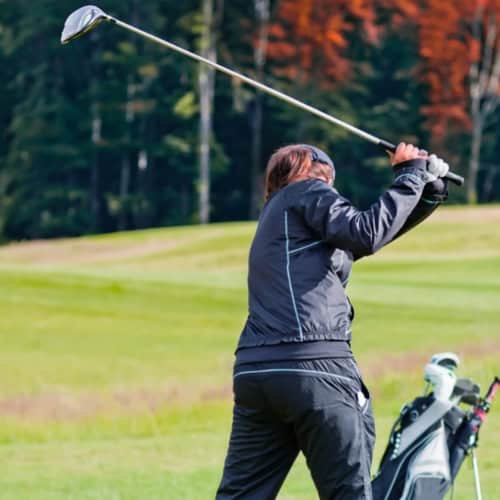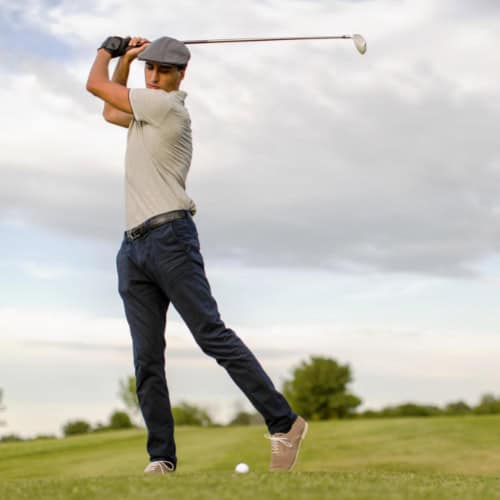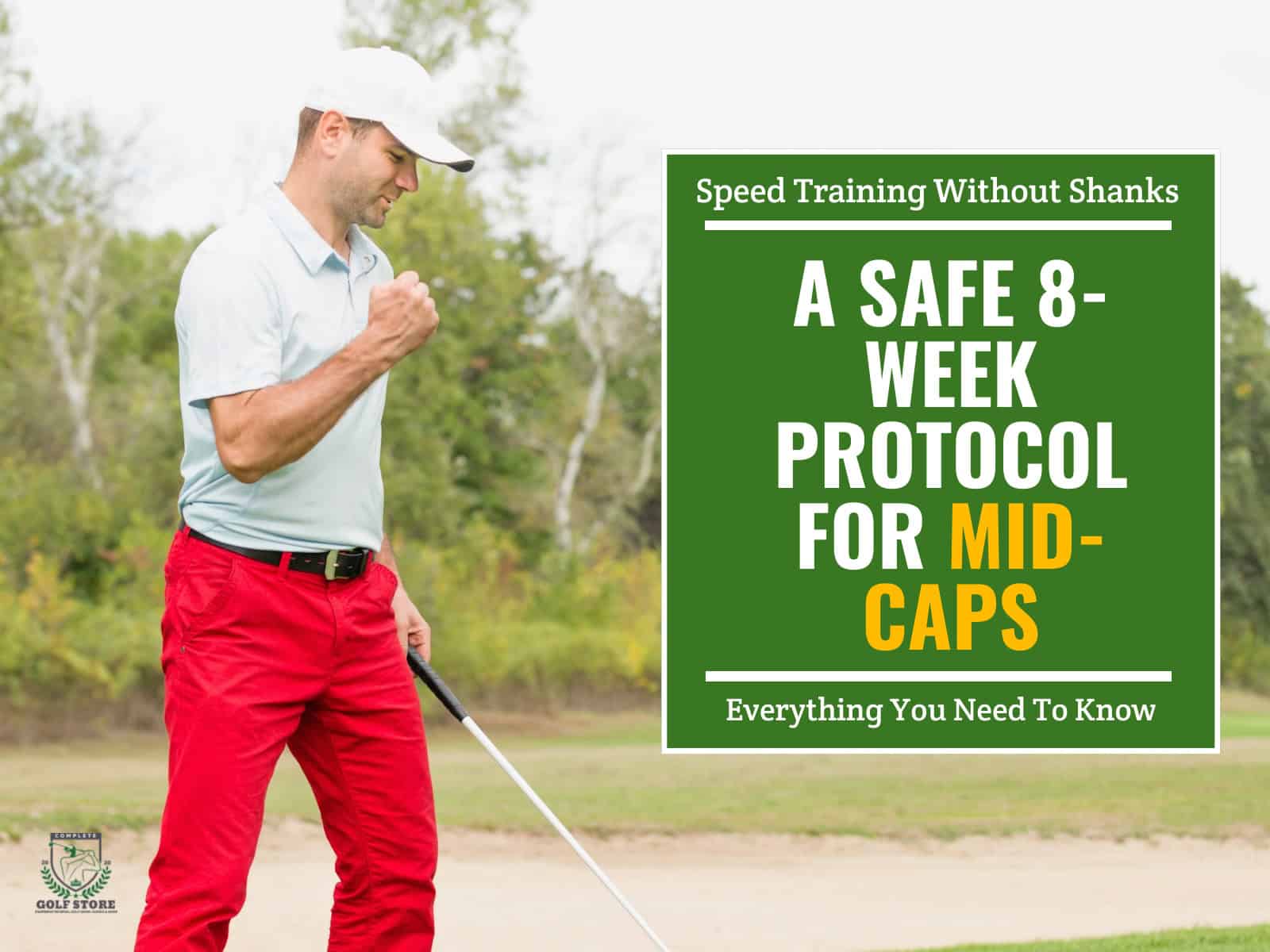A perfect golf backswing is the foundation of a consistent and powerful swing, unlocking your full potential on the course. By mastering the backswing, you’ll hit longer, straighter and more accurate shots.
In this article, we’ll cover the mechanics of the backswing, from setup to the top. You’ll learn about proper body positions, movements and key checkpoints to build a solid and repeatable backswing. We’ll also explore the role of flexibility and strength and provide expert tips and drills to refine your technique.
- 1) Proper Setup and Initial Movements
- 2) Body Position and Movement During the Backswing
- 3) Key Mechanics and Drills for a Perfect Backswing
- 4) The Role of Flexibility and Strength in the Backswing
- 5) Expert Tips for Mastering Your Backswing
-
6)
Frequently Asked Questions
- 6.1) How can I ensure my left arm remains straight during the backswing?
- 6.2) What is the difference between a proper hip turn and swaying in the backswing?
- 6.3) How can I maintain the right shoulder position throughout the backswing?
- 6.4) What are some common mistakes golfers make during the backswing, and how can they be avoided?
- 6.5) How much should my wrists hinge during the backswing?
- 6.6) What is the optimal club position at the top of the backswing?
- 6.7) How can I improve my flexibility to achieve a better backswing?
- 6.8) What drills can I practice to improve my backswing mechanics?
- 6.9) How does the backswing differ for various golf clubs, such as drivers, irons and wedges?
- 7) Final thoughts
Proper Setup and Initial Movements
A solid backswing begins with the right setup. Start by taking a shoulder-width stance, with your feet parallel to your target line. Bend your knees slightly, keeping your back straight and your neck in line with your spine. This athletic posture will allow you to maintain balance and generate power throughout your swing.
Before you begin your backswing, it’s crucial to ensure you’re properly aligned with your target. Learning steps to perfect your golf shot setup can significantly improve your overall swing mechanics and shot accuracy. Once you’ve mastered the alignment, you can focus on the following aspects of your setup and initial movements.
As you initiate your backswing, focus on keeping your left arm straight. This will help you maintain control and consistency in your swing. Your left heel should remain on the ground, providing a stable base for your body to rotate around. Meanwhile, your right knee should maintain its flex, allowing for a smooth weight transfer during the backswing.
The Takeaway
The takeaway is the first movement of your backswing, and it sets the stage for everything that follows. Initiate the takeaway by rotating your shoulders, with your hands, arms and shoulders moving together as a unit. This one-piece motion ensures that your club stays on plane and your body remains synchronized.
As you rotate your shoulders, your hips will naturally start to open. Allow your right leg to work back, facilitating this hip rotation. Remember, the takeaway should be a smooth, gradual motion—not a jerky or rushed movement.
Focus on maintaining a straight left arm, a stable left heel, and a flexed right knee while initiating the takeaway with a synchronized shoulder rotation. With practice, these fundamentals will become second nature, allowing you to swing with confidence and consistency on the course.
Body Position and Movement During the Backswing

Once you’ve mastered the proper setup and takeaway, it’s crucial to focus on your body position and movement throughout the backswing. One key aspect is maintaining a stable head position. Your head should stay in the same spot, both horizontally and vertically, as you rotate your body. This helps you maintain your posture and balance, ensuring a more consistent swing plane.
Through the backswing, you’ll notice a natural weight transfer to your right foot. This shift is essential for generating power and maintaining balance. However, be careful not to sway your hips backward during this weight transfer. Swaying is a common swing error that can lead to inconsistency and loss of power. Instead, focus on a gradual hip rotation, allowing your hips to coil as your club shaft becomes parallel to the ground.
Maintaining Posture and Angles
To ensure a proper backswing, pay attention to your right shoulder and hip. Your right shoulder should stay high throughout the backswing, helping you maintain your spine angle and posture. Avoid letting your right shoulder dip or collapse, as this can cause you to lose power and consistency.
Similarly, your right hip should turn back, allowing for a centered turn. As your right hip rotates, your right leg should move back behind you, which helps you maintain your balance and creates a coiled position from which you can generate maximum power on your downswing.
Key Mechanics and Drills for a Perfect Backswing
To achieve a perfect backswing, it’s essential to focus on the key mechanics and incorporate targeted drills into your practice routine. One crucial aspect is the wrist hinge, which should occur halfway back during your backswing. By hinging your wrists correctly, you’ll keep the club in front of your body and on plane, setting yourself up for a powerful and accurate downswing.
The takeaway is a crucial element of your backswing that sets the foundation for a successful swing. To master this important technique, you may want to explore specific drills to perfect your golf swing takeaway. These exercises can help you develop muscle memory and improve the consistency of your initial backswing movement.
The Five Essential Parts of a Proper Golf Backswing

To perform the perfect backswing, make sure you bear in mind the following tips (Some were mentioned earlier, but it helps to have them all listed):
- Takeaway with clubhead in line or outside hands: As you initiate your backswing, ensure that your clubhead stays in line with or slightly outside your hands. This positioning helps you maintain control and keep the club on the correct path.
- Right shoulder stays high to maintain posture and angles: Throughout your backswing, focus on keeping your right shoulder high. This helps you maintain your spine angle and posture, ensuring a more consistent swing plane.
- Wrists hinge up halfway back, keeping the club in front and on plane: Halfway through your backswing, allow your wrists to hinge upward. This move keeps the club in front of your body and on plane.
- Right hip turns back for a centered turn: As you continue your backswing, your right hip should turn back, allowing for a centered rotation. This movement helps you maintain balance and create coil, which translates to more power in your swing.
- Flat lead wrist, cupped trail wrist, and matching shoulder plane at the top: At the top of your backswing, your lead wrist should be flat, while your trail wrist should be slightly cupped. Your shoulders should match your swing plane, ensuring a smooth transition into your downswing.
Drill for a Perfect Backswing Tempo
One key to a great backswing is maintaining a slower pace compared to your downswing. To ingrain this tempo, try the following drill:
- Set up to the ball as you normally would.
- Take your backswing at half your usual speed, focusing on the key mechanics mentioned above.
- Pause for a moment at the top of your backswing.
- Initiate your downswing, allowing it to be slightly faster than your backswing.
- Repeat this drill several times, gradually increasing your backswing speed while still maintaining a slower pace than your downswing.
The Role of Flexibility and Strength in the Backswing

While mastering the technical aspects is crucial, it’s equally important to understand the role that flexibility and strength play in executing a proper backswing. Your core muscles, particularly the obliques and erector spinae, are essential in generating the rotational power needed for a smooth and effective backswing.
The Importance of Core Muscles
Your core muscles act as a bridge between your upper and lower body, allowing for a coordinated and powerful backswing.
The obliques, located on the sides of your abdomen, help initiate the rotation of your torso during the backswing.
The erector spinae, which run along your spine, assist in maintaining your posture and stabilizing your trunk throughout the swing.
Addressing Thoracic Spine Tightness
Tightness in the thoracic spine, the middle portion of your back, can significantly hinder your backswing. A lack of mobility in this area can lead to a limited shoulder turn and an overcompensation in other parts of your body, potentially causing inconsistencies and even injuries.
To improve your thoracic spine mobility, consider incorporating these stretches into your routine:
- Tabletop Thoracic Twist: Start on your hands and knees, with your hands directly under your shoulders and knees under your hips. Place your right hand behind your head, then rotate your right elbow towards the ceiling. Hold for 30 seconds, then repeat on the opposite side.
- Child’s Pose Twist: Begin in a child’s pose, with your arms extended in front of you. Walk your right hand towards your left hand, feeling a stretch in your mid-back. Hold for 30 seconds, then repeat on the opposite side.
Strengthening Your Mid-Back
In addition to flexibility, strength in your mid-back is crucial for maintaining the proper backswing position and generating power. One effective exercise for strengthening and mobilizing your mid-back is the Dynamic Y-Raise:
- Stand with your feet shoulder-width apart, holding a pole or golf club in front of you with an overhand grip.
- Raise the pole overhead, keeping your arms straight, until you feel a stretch in your lats and mid-back.
- Lower the pole back to the starting position and repeat for 10-15 repetitions.
Expert Tips for Mastering Your Backswing
Now that you have a solid understanding of the key mechanics and the role of flexibility and strength in the golf backswing, it’s time to go through some expert tips that will help you refine your technique and achieve a more consistent, powerful swing.
The Halfway Back Position
The halfway back position is where your club shaft is parallel to the ground, and your wrists have begun to hinge. Focusing on achieving a good halfway back position can make completing a full, proper backswing much easier.
To master this position, allow your wrists to start cocking upwards once the club reaches hip height. At this point, the club should be on plane, with the butt end of the club pointing directly at the ball when viewed from behind. Avoid rolling or rotating your wrists; instead, focus on a hinging or cocking motion.
The “Pre-Set Drill”
Nick Faldo, a six-time major champion, popularized a drill known as the “pre-set drill” to help golfers achieve the perfect backswing position. Here’s how to perform the drill:
- Set up to the ball as normal, but hinge your wrists fully at address, so the club shaft is parallel to the ground.
- From this position, make a full turn to the top of your backswing, maintaining the hinge in your wrists.
- Pause at the top, checking that your club is on plane and your body is in the correct position.
- Return to the starting position and repeat the drill several times to ingrain the feeling of a proper backswing.
By practicing this drill regularly, you’ll develop muscle memory for the correct backswing positions and plane. Here is a video (58 sec.) to where Faldo himself illustrates the drill:
Consistency is Key
Consistently finding the correct position at the top of your backswing is essential for executing a powerful and accurate downswing. Some key checkpoints to look for at the top of your backswing include:
- A full shoulder turn with your back facing the target
- Your left arm is relatively straight, and your right elbow is pointing down
- Your wrists are fully hinged, with the club shaft parallel to the ground or slightly above parallel
- Your weight is shifted predominantly onto your right side
Frequently Asked Questions
The following are commonly asked questions to help you further perfect your backswing and improve your overall game.
How can I ensure my left arm remains straight during the backswing?
To keep your left arm straight during the backswing, focus on maintaining tension in your left arm muscles. Practice slow, deliberate backswings while consciously keeping your left arm extended. Over time, this will become a natural part of your swing.
What is the difference between a proper hip turn and swaying in the backswing?
A proper hip turn involves a rotation of the hips around the spine, with the right hip turning back and the left hip turning forward. Swaying, on the other hand, is a lateral movement of the hips towards the right foot, which can lead to inconsistency and loss of power.
How can I maintain the right shoulder position throughout the backswing?
To maintain the right shoulder position, focus on keeping your right shoulder high and your right arm connected to your body. Avoid letting your right shoulder dip or your right elbow flare out. Practice in front of a mirror to monitor your shoulder position.
What are some common mistakes golfers make during the backswing, and how can they be avoided?
Common mistakes include the following:
– Swaying instead of turning: Focus on rotating your hips rather than shifting them laterally.
– Losing posture: Maintain your spine angle and avoid standing up or slouching during the backswing.
– Overswinging: Stop your backswing when your left shoulder is under your chin and your back is facing the target.
How much should my wrists hinge during the backswing?
Your wrists should hinge naturally during the backswing, with the club shaft reaching a position parallel to the ground at the halfway point. Avoid artificially hinging your wrists or keeping them too rigid.
What is the optimal club position at the top of the backswing?
At the top of the backswing, the club shaft should be parallel to the ground or slightly above parallel, with the clubface pointing towards the sky. Your left arm should be relatively straight, and your right elbow should be pointing down.
How can I improve my flexibility to achieve a better backswing?
To improve flexibility, incorporate stretches for your shoulders, back and hips into your daily routine. Yoga and Pilates can also help improve overall flexibility and core strength, which are essential for a proper backswing.
What drills can I practice to improve my backswing mechanics?
Some additional helpful drills include:
– The one-piece takeaway drill: Focus on moving your arms, shoulders and club as one unit during the initial takeaway.
– The pause drill: Make a backswing and pause at the top, checking your position before starting the downswing.
– The half-swing drill: Practice making shorter backswings, focusing on proper form and control.
How does the backswing differ for various golf clubs, such as drivers, irons and wedges?
The main difference in the backswing for various clubs lies in the length and plane of the swing. With a driver, you’ll make a slightly longer backswing with a more upright plane. For irons and wedges, the backswing will be shorter and more rounded. However, the fundamental mechanics remain the same across all clubs.
Final thoughts
Throughout this comprehensive guide, we’ve explored the essential elements of a perfect golf backswing, from the initial setup to the top of the swing. We discussed the importance of proper stance, body position and movement, as well as key mechanics and drills for a well-executed backswing. The guide also highlighted the crucial role of flexibility and strength in the backswing, particularly focusing on core muscles and thoracic spine mobility.
A perfect backswing is a combination of proper setup, precise body movements, key mechanics, flexibility, strength, and expert techniques. By focusing on these critical elements and dedicating time to practice and refinement, you’ll unlock your full potential on the course and enjoy a more consistent, powerful and enjoyable game.
Thanks for reading!





